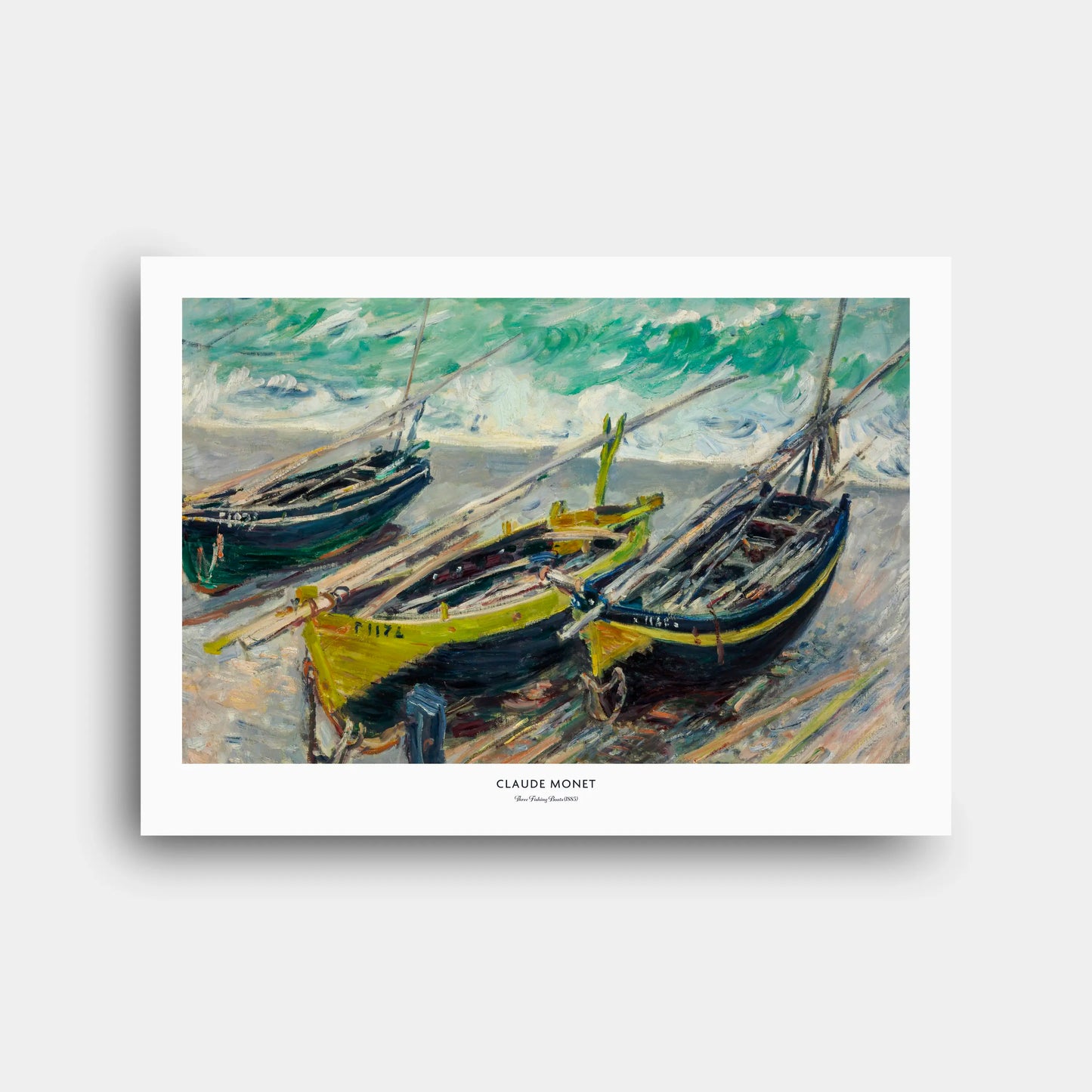Claude Monet - Three Fishing Boats (1885) - Paper Poster N169
Claude Monet - Three Fishing Boats (1885) - Paper Poster N169
Couldn't load pickup availability
Share
Paper Poster | Canvas Print | Digital File
1. Historical and Artistic Context
Claude Monet painted “Three Fishing Boats” in 1885 during his time on the Normandy coast, a period marked by his fascination with maritime life and the interplay between human labor and the natural world. The Normandy shoreline, especially around Étretat, became one of Monet’s key motifs in the 1880s. Fishing communities, with their boats pulled ashore after daily work, offered him a subject that combined vivid color, dynamic forms, and transient light effects. This work sits at an important moment in Monet’s career, bridging his earlier explorations of urban and suburban life along the Seine with his later serial paintings that examined nature’s changing conditions in systematic cycles.
2. Technical and Stylistic Analysis
The composition is strikingly dynamic, with three boats angled diagonally across the foreground, their prows pointing toward the viewer and their masts stretching toward the sea. Monet uses short, energetic brushstrokes to evoke the movement of water and the rough texture of sand, while broader, more confident strokes define the structures of the boats. The color palette balances vivid greens and yellows with deep blues, creating a sense of visual vibration. The sea is depicted with swirling brushwork, suggesting motion and the ever-changing nature of the waves. The boats, although more solid, still possess a looseness of line that allows them to merge harmoniously with their surroundings.
3. Symbolism and Interpretation
Though Monet was not a symbolist painter, his choice of subject carries subtle meaning. The three boats can be read as metaphors for resilience, community, and humanity’s relationship with the unpredictable sea. Positioned between land and water, they embody transition—moments of pause between labor and risk, safety and danger. Their bright colors against the turbulent background suggest endurance and hope. The tilted spars point toward the ocean, symbolizing readiness for what lies ahead. In this way, the painting captures more than a coastal scene; it reflects broader themes of survival, adaptation, and harmony with nature.
4. Technique and Materials
Monet employed oil on canvas, working quickly en plein air to capture the immediacy of light and atmosphere. His brushwork varies from thick impasto on the boats’ surfaces to lighter, fluid strokes in the waves and sand. Pigments likely included ultramarine and Prussian blue for the sea, chrome yellow for the boat hulls, and viridian green mixed with white for the luminous water tones. The textured layering of paint enhances the sense of depth and energy, while the warm ground of the canvas shows through in places, intensifying the vibrancy of the palette.
5. Cultural Impact
Paintings such as “Three Fishing Boats” contributed to a broader cultural shift in which the everyday lives of working people became worthy subjects of fine art. By depicting humble fishing craft with the same intensity as cathedrals or landscapes, Monet elevated the ordinary into something universal. These coastal works shaped perceptions of Normandy fishing towns and influenced marine painting across Europe. They also appealed strongly to collectors abroad, especially in the United States, where Impressionism’s fresh vision of modern life resonated deeply.
6. Critical Reception and Scholarly Interpretations
Critics and scholars have praised the painting for its balance of structure and spontaneity. Formalist readings emphasize the strong diagonals that provide stability to an otherwise dynamic scene, while social historians interpret the subject as a window into the rhythms of coastal communities. Conservation studies highlight Monet’s process, revealing how he embraced visible brushwork and avoided heavy reworking, allowing the painting to reflect the immediacy of observation. More recently, art historians have situated this painting within Monet’s transition toward serial explorations, identifying it as part of his experimentation with light, season, and atmosphere.
7. Museum, Provenance and Exhibition History
“Three Fishing Boats” belongs to a group of works painted by Monet in the mid-1880s along the Normandy coast. Many of these canvases were handled by the Paris dealer Paul Durand-Ruel, who played a crucial role in promoting Monet’s art internationally. While specific provenance records for this canvas vary across versions, similar works entered both French and American collections by the late 19th century, where they were quickly embraced by private collectors and later by major museums. Today, such works continue to circulate between public exhibitions and private holdings, underscoring their enduring appeal.
8. Interesting Facts
1. Monet often secured his easel with stones to withstand coastal winds.
2. The depicted fishing boats are typical of Normandy skiffs, hauled ashore daily.
3. He sometimes painted multiple versions of the same subject in a single day.
4. The diagonal arrangement of boats reflects Monet’s interest in photographic framing.
5. Sand and salt spray have been found embedded in some of his coastal canvases.
6. The numbers on the hulls are suggestive rather than exact, prioritizing impression over documentation.
7. Monet frequently worked on small to medium canvases outdoors for portability.
8. The luminous green of the water comes from layered blends of viridian, yellow, and white.
9. These coastal works were especially popular with American collectors in the 1880s and 1890s.
10. The three-boat motif recurs in several Monet works, each capturing a different season or time of day.
9. Conclusion
Claude Monet’s “Three Fishing Boats” exemplifies Impressionism’s ability to transform an everyday subject into a vibrant meditation on color, light, and human presence within nature. Through energetic brushwork and bold chromatic contrasts, the painting captures both the immediacy of a fleeting coastal moment and the timeless narrative of labor and resilience. It stands as a testament to Monet’s mastery in balancing sensation and structure, offering viewers not just a glimpse of Normandy’s shores, but an enduring reflection on humanity’s bond with the sea.











